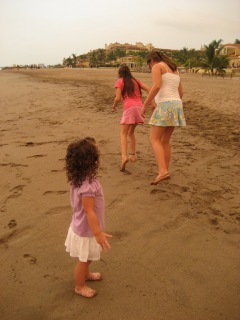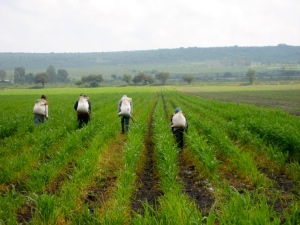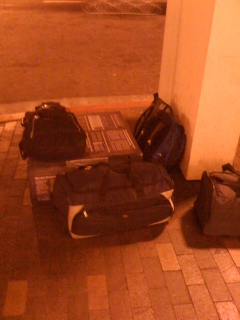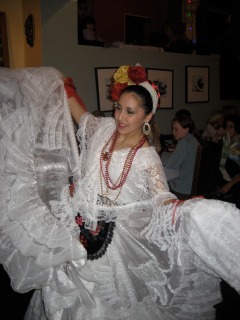I’m trying to get back on track with my blog. It was fun, and it helped me to remember what was happening in our life here in Mexico. A chronicle, a reminder of our learning process here, in music, performance, in farming, and all the little things that make up a life. I stopped blogging mainly because of my sorry, horrible connection on line. I don’t want to include the boring details, but believe me, it was SO frustrating! Now I have a less wonky connection, and I hope to start up again.
Author Archives: gubabbaboy
Last Year’s Harvest
Starting Over (well, sort of)
IT’S A VERY SMALL TOWN
Starting Over (well, sort of)
I recently (yesterday!) regained access to this blog. Thank you, Google forum! That’s a pretty good excuse not to have written anything for a long time, I’d say.
The first thing I did was to moderate some comments (I got some comments!) and to peruse some of the old entries. I had thought after not seeing it for a while that I just might not like it. But I do. I still do.
So I have some catching up to do, and this is a start.
Reasons I didn’t blog:
1. I really did not notice that I didn’t have access to the blog. Because????
2. There was really nothing going on for a while; no practicing/performing. No farming. Lots of reading (I guess I could blog about reading, but – nah.)
3. We got really busy with farming, and I was waaay too busy to write about it. Really. Busy every single day.
4. We got busy with music, with hours and days of practicing.
5. We were taking care of la señora, who got a horrible infection.
And that’s the year, condensed.
So, my dear readers, guess what I’ll be writing about very soon!!
La Siembra, practicing, performing, caring for an old, old lady, losing and re-evaluating having a blog.
Can you see where this is going? I hope it won’t be boring.
Navidad – Going To Mexico
Our recent annual Posadas Parties gig in downtown Los Angeles ended quietly on December 24th. As we were setting up several employees asked if the evening would end earlier than the other nights, and Yes, we said. We used less equipment and smaller speakers, and shortened the times between events, so that we ended about 9:15 instead of at 10 p.m.
YES, WE ARE WORKING MUSICIANS
 |
| Audience participation can be stunning! |
ATOTONILCO EL ALTO
 Nearby Jalpa’s patronal fiesta was held over the last weekend. Before we left, we drove to there to buy some bread from one of the vendors before they pulled up stakes and left for another fiesta. There were lots of candy vendors, with marzipan and a variety of candies made from squashes and yams. There were several vendors of kitchen items, and plastic buckets and pans of all sizes.The children’s games were still there, too. The bread vendors carry their ovens around with them, and one had large beautiful bread coming right out of the oven. Chon bought one to take with us to Juana, his sister.
Nearby Jalpa’s patronal fiesta was held over the last weekend. Before we left, we drove to there to buy some bread from one of the vendors before they pulled up stakes and left for another fiesta. There were lots of candy vendors, with marzipan and a variety of candies made from squashes and yams. There were several vendors of kitchen items, and plastic buckets and pans of all sizes.The children’s games were still there, too. The bread vendors carry their ovens around with them, and one had large beautiful bread coming right out of the oven. Chon bought one to take with us to Juana, his sister. In the mercado Chon made a deal for a pair of huaraches for 90 pesos, and we stopped in at a couple of “cibers” to try to purchase a USB extension cord. It began to rain, harder and harder. We wanted to get to Juana’s house before it got late, so we headed back to the car, and back towards Arandas, the famous tequila town. We stopped at our favorite “private label” merchant (in this case, private label means no label at all), and bought a garrafon to take home. We headed past the very old church with its very old, very heavy bell still hanging in its temporary spot, and drove toward Juana’s house.
In the mercado Chon made a deal for a pair of huaraches for 90 pesos, and we stopped in at a couple of “cibers” to try to purchase a USB extension cord. It began to rain, harder and harder. We wanted to get to Juana’s house before it got late, so we headed back to the car, and back towards Arandas, the famous tequila town. We stopped at our favorite “private label” merchant (in this case, private label means no label at all), and bought a garrafon to take home. We headed past the very old church with its very old, very heavy bell still hanging in its temporary spot, and drove toward Juana’s house. We wound down the mountain road, passed through Doblado, and arrived home after 8 p.m.
QUICK TRIP TO PUERTO VALLARTA
 We followed the coastline south to Puerto Vallarta and searched for the Marriott, and overshot it by quite a ways, so we got an idea of the town. Although there are luxurious hotels and many tourist attrations, the town is old and rather charming. Drivers: Vallarta is one of those places where to turn left, you must get onto the right parallel road, called a lateral. Then you may turn left, across the traffic on the main part of the road, on a light. After locating the motel and finding our way to the check-in desk through a light drizzle, we arrived at our room, adjoining our hosts who were in a large suite. They needed the space because of all the things they had brought – crib, stroller, sports equipment. There was a refrigerator and a balcony overlooking the beach, and sea turtle release program. In the afternoons you can attend a release of baby sea turtles on the beach. Breilyn and I went for a stroll on the beach, hoping to see that.
We followed the coastline south to Puerto Vallarta and searched for the Marriott, and overshot it by quite a ways, so we got an idea of the town. Although there are luxurious hotels and many tourist attrations, the town is old and rather charming. Drivers: Vallarta is one of those places where to turn left, you must get onto the right parallel road, called a lateral. Then you may turn left, across the traffic on the main part of the road, on a light. After locating the motel and finding our way to the check-in desk through a light drizzle, we arrived at our room, adjoining our hosts who were in a large suite. They needed the space because of all the things they had brought – crib, stroller, sports equipment. There was a refrigerator and a balcony overlooking the beach, and sea turtle release program. In the afternoons you can attend a release of baby sea turtles on the beach. Breilyn and I went for a stroll on the beach, hoping to see that.The Marriott is sumptuous, especially for folks accustomed to life in a tiny town. There are many shops and many eating choices, and of course, a pool. Dion and Laurel took us out to a wonderful Japanese dinner, with fancy spatula tossing, and a meal prepared in front of us on a large grill. The fried rice prepared by our chef was very good. Normally fried rice is probably not something one would mention, but really, it was wonderful. We had Mahi Mahi, the “catch of the day”.
Once in town, you notice very clean, rock roads, and closed-off houses. The people were friendly, some girls telling us that the daily wage there is 100 pesos (less than ten dollars). That, combined with the high prices for necessities, makes for a difficult life. (Men are sometimes paid 150 pesos/day for labor, according to the same source.) This is another thing, I might venture, that the area has in common with the Sonora area of California.
As we continued toward Guadalajara and home we stopped at a view point high above Mascota for a couple of photos. At the same spot was a pickup with the hood up, and a family watching the daddy peering into the engine cavity. Chon asked what the problem was, and the man told him that suddenly there had been “oil” spraying all over, and it had soaked the right front tire. After some conversation and thoughtful analysis of our own past experience, Chon decided that it likely was the transmission fluid. And it was. The guy handed us 500 pesos (displaying an unusual amount of trust) and we went back down to the nearest gas station and purchased two bottles of transmission fluid, returned, and added it to the car. When he switched it on again, the fluid again began to spew. Closer examination revealed a hose with a big cracked place, luckily near the place it was fastened. The man handily cut of the damaged part and replaced the clamp. During the time we were there, we all made friends. There were two little boys with their mom, and we all shared pretzel chips (thank you, Laurel) and chatted. When we took off again, it was with the phone number of the man, who lives in Las Vegas, Nevada, and a standing invitation to a big steak dinner whenever we might be passing through.
Hello world!
Welcome to WordPress.com! This is your very first post. Click the Edit link to modify or delete it, or start a new post. If you like, use this post to tell readers why you started this blog and what you plan to do with it.
Happy blogging!























